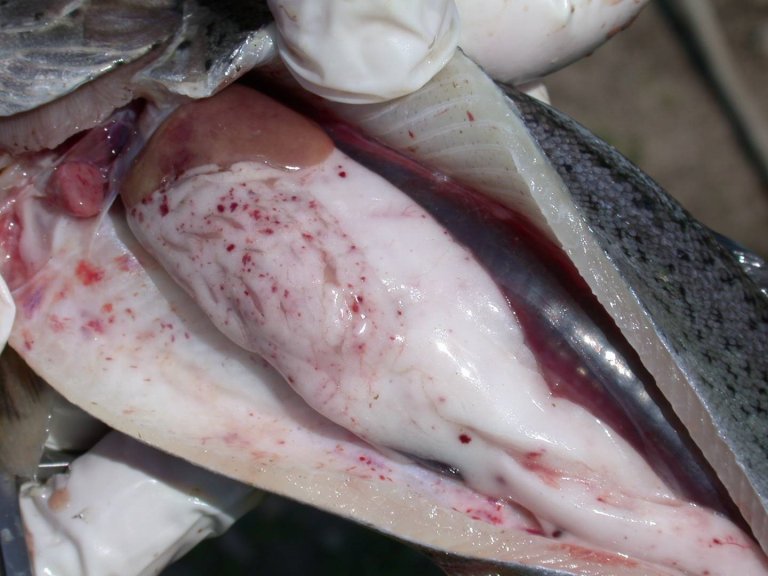
Photo: Ole Bendik Dale, Norwegian Veterinary Institute
Outbreaks causing high mortality in aquaculture primarily affect rainbow trout.
VHS is notifiable in both Norway and the EU (Categories C+D+E). Detection or suspicion of VHS must be reported immediately to the Norwegian Food Safety Authority.
Pathogen and Transmission
The disease is caused by the VHS virus, a member of the genus Novirhabdovirus in the family Rhabdoviridae. These are enveloped, single-stranded RNA viruses. Four genotypes of VHSV have been identified: Genotype I, II, III, and IV, which can be further divided into subtypes such as Ia, IVa, IVb, etc. Some genotypes tend to affect only a single fish species, while others have a broader host range.
Genotype Ia is the primary cause of high mortality in rainbow trout. This genotype affects both freshwater and marine environments, whereas the other genotypes are predominantly found in saltwater and are often referred to as marine variants.
There have been a few outbreaks caused by marine variants of VHSV in rainbow trout and other farmed fish species. As the virus can adapt to new hosts, it is crucial to prevent the establishment of any VHSV genotypes in Norwegian aquaculture.
The virus can survive in water at low temperatures (below 4°C) and in frozen fish but is inactivated by common disinfectants and temperatures above 70°C. Infected fish shed the virus through urine, and transmission primarily occurs through contact with infected fish or contaminated water. Feeding raw, unheated fish has been shown to transmit the virus and was likely the source of several outbreaks in the 1960s and 1970s.
Clinical Signs
Acute disease in rainbow trout typically occurs at water temperatures between 4°C and 14°C and is characterized by high mortality, hemorrhages, anemia (pale gills), exophthalmia (bulging eyes), and abdominal distension. Abnormal swimming patterns, such as spiral swimming and "blinking," may also be observed. Necropsy often reveals hemorrhages in the muscles and internal organs, especially the swim bladder.
Diagnosis
Microscopic examination of tissue from acute cases may show necrosis in hematopoietic tissue in the kidney and spleen, along with hemorrhaging in multiple organs. VHSV can be detected in tissues using specific antibody staining, as well as cultivation in cell culture and molecular techniques such as PCR. In some cases, the virus is only found in brain tissue, making brain samples important in addition to standard organ sampling.
If VHS is detected in Norway, samples will be sent to the EU Reference Laboratory for Fish and Crustacean Diseases in Denmark for confirmation.
Differential Diagnoses
Differential diagnoses include Infectious Hematopoietic Necrosis (IHN), caused by another rhabdovirus, and bacterial infections leading to septicemia. Hemorrhagic Smolt Syndrome (HSS) may also present macroscopically similar signs.
Occurrence
VHS was first discovered in rainbow trout in Denmark and was initially thought to be specific to that species. Since the mid-1980s, the virus has been detected in various marine fish species, with outbreaks also reported in wild fish along the Pacific coast of the USA and in the Great Lakes. To date, VHSV has been found in about 80 different fish species and is primarily distributed in the Northern Hemisphere.
In Norway, VHS Genotype Ia was sporadically detected in farmed rainbow trout from the mid-1960s. A control program was initiated, and the disease was officially eradicated in 1974. In 2007 and 2008, VHS caused by Genotype III was detected in rainbow trout in Møre og Romsdal. Control measures were implemented, and Norway regained its VHS-free status.
Marine variants of VHSV have been isolated from wild marine fish in Norwegian waters, but Genotype Ia has not yet been detected in wild fish in Norway. While VHS outbreaks have been observed in wild fish in the USA, none have been reported in Norway. It is critical to keep farmed fish free of VHSV for the protection of both farmed and wild populations. Wild fish may always represent a potential source of infection. VHSV has been found in cleaner fish in Scotland and Iceland, and their use in biological delousing may pose a transmission risk to farmed fish.
Surveillance
Norway has been VHS-free since 1994. A surveillance program began in 2004, and when VHS was detected in farmed rainbow trout in 2007, eradication measures were taken. VHS-free status was regained in 2011.
The surveillance program is now risk-based and includes active sites with Atlantic salmon and rainbow trout. Samples submitted to the Norwegian Veterinary Institute for suspicion of or monitoring of other listed diseases, or for general disease diagnostics, are also tested for VHSV and IHNV using PCR. Since 2021, rainbow trout from inland aquaculture have been tested for IHNV, and in 2022, brown trout from hatcheries and grow-out facilities were included. That same year, samples from wild fish were inoculated into cell lines susceptible to IHNV, and fish with high mortality or histological findings were also tested using PCR.
Surveillance Program for VHSV and IHNV
Control Measures
VHS is notifiable in both Norway and the EU (Categories C+D+E), and outbreaks are handled through “stamping out,” i.e. destruction of infected fish. Protection zones with strict movement and transport restrictions are established around affected sites.
There is currently no approved vaccine against VHS in Norway.
